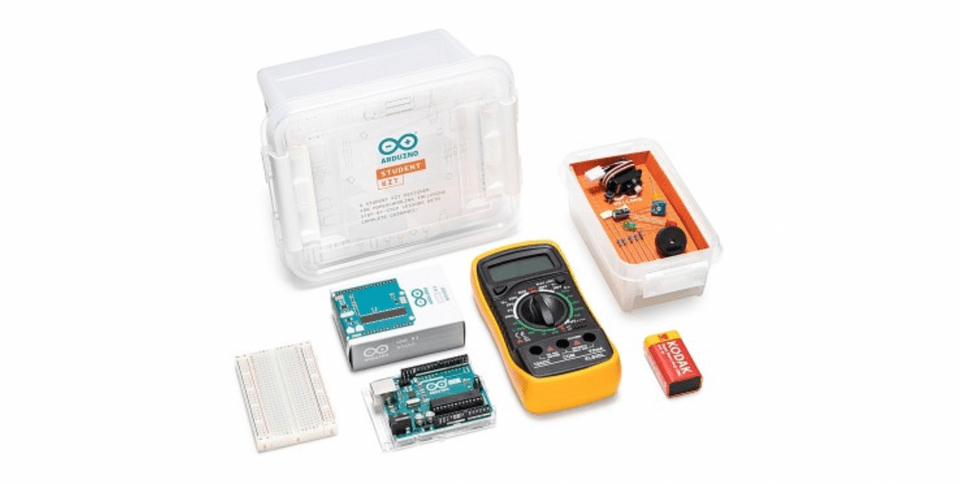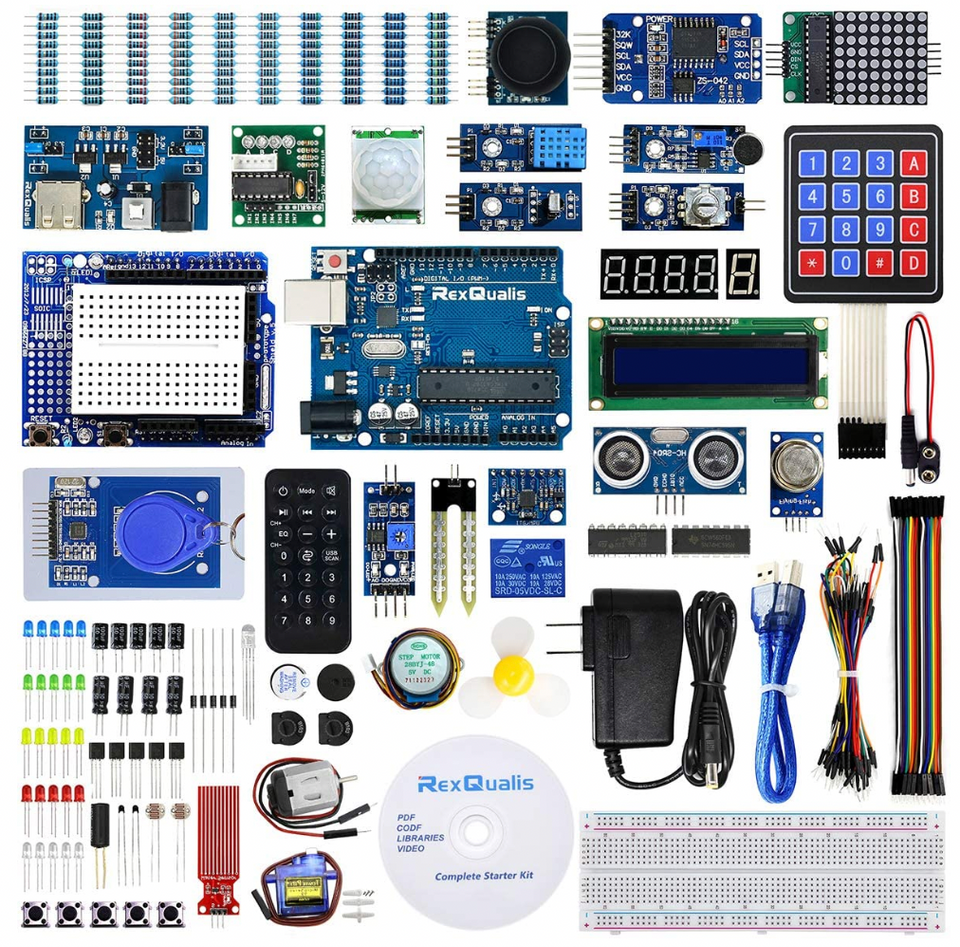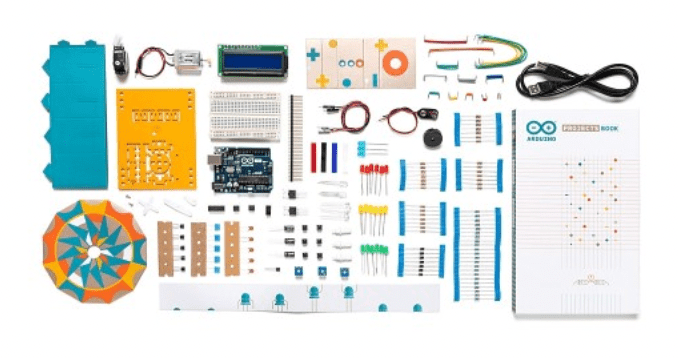Arduino kits offer an easy way to help your child learn about electronics and programming.
Looking for a starter kit for a curious 8 year old? Or are your children interested in electronics or software? If so, it would be beneficial to consider Arduino kits for kids.
So what is Arduino? An Arduino is a device to control electronics. It can read in information from sensors and control things like motors and lights. Arduinos use code to understand the sensors, and decide when to turn on the motors and lights. These pre-made kits come with all the parts you need to build circuits, gadgets, and even robots!
They can be used to follow along with our live online Arduino for kids classes designed by experts from Google, Stanford, and MIT, so that your children can make the projects in person as well as in simulation. Or, you can use them to allow your children to try their hand at building new circuits with the knowledge they gained from these classes.
Which Arduino should I start with?
When looking for a starter kit, consider what you want the kit for. If the kit is for following along during lessons, the kit will not need to include an instruction book, but will need to include all of the parts needed for lessons, listed below. If the kit is for exploring beyond the class, the components included in the kit can vary more, but you may want an instruction booklet with project ideas. You can usually look up the “Tech Specs” to see exactly what the kit includes.
Parts needed for classes:
- Arduino Uno
- Breadboard
- Jumper Wires
- Resistors
- Piezo
- LEDs (at least 8)
- RGB LED
- Potentiometer
- Button
- Temperature Sensor
- Servo Motor
- DC Motor
- Ultrasonic Sensor
It is also important to consider which Arduino board is included in the kit. Some of the options can be seen in the image below. The Arduino Uno is a good choice for most applications. There are also generic versions of these boards, but the generic versions often have trouble connecting to the Arduino IDE, the computer application where code is written and uploaded to the Arduino board. Genuine Arduino Uno boards will always say “Arduino” on them. You do have the option of buying a kit that includes a generic board, and simply buying a genuine Arduino board to use in the kit instead. All components in these kits should be compatible with all boards.
Also be aware of whether the pins come attached. If the pins do not come attached, you will have to solder them on yourself. To know if the pins do come attached, look at the holes around the edge of the board. If they are empty, you will have to solder the pins yourself, which we would not recommend unless you have experience soldering. In the image below, you can see that the Uno, Leonardo, and Mega have the pins soldered for you, but the Mini, Lilypad and Nano do not.

What is the best Arduino starter kit for beginners?
There are hundreds of starter kits available, and which one is right for you depends on your individual needs. Here are our recommendations for complete starter kits for those working on a budget, those with fast learners, those looking for a high performance kit, and more. These kits will give you all the components you need to work on a variety of Arduino projects.


1. The official Arduino student kit
The Official Arduino Student Kit is a solid starting place for those with little to no experience with Arduino. It comes with enough components for several projects, a genuine arduino board with pre-soldered pins, and even a sturdy storage box. The big draw of this kit, however, is that it comes with access to an online curriculum that includes learning guidance notes, step-by-step lessons and extra materials such as resources, invention spotlights and a digital logbook with solutions. Another unique feature of this kit is that it includes a multimeter, a useful tool for diagnosing problems with circuits, and learning more about how they function.
This is one of the less expensive kits on this list, and as such it is somewhat limited in the components included. It is an excellent place to start, but your child will likely want additional sensors and motors to experiment with after they complete the included lessons.

2. The best Arduino kit for your budget
At around $30, this Miuzei Starter Kit is an excellent choice for those on a budget. It includes a good variety of components, and even some tutorials. If you have a bit of experience, we believe this is a great kit. As the board is generic, it may not always work with the Arduino IDE. Additionally, you should be aware that the instructions come on a mini-CD.

3. An Arduino kit for the whole family
If you’re looking for a kit for the whole family, the Arduino Education Kit is an excellent choice. It comes with enough components for 4 people to build projects. It comes with step-by-step instructions for 9 90-minute lessons, plus two open-ended projects. You can build along with your kids, or just help them. Since each child has their own parts, they can work at their own pace, and there will be no fighting over components.

4. Most bang for your buck
This Arduino UNO R3 kit is a better value than most, as it contains over 200 components, including a huge variety of sensors, a good selection of LEDs and displays, and 3 different types of motors. It has enough components to make 31 projects, and does come with tutorials for all of them on a CD. While the board is generic, it should be compatible with the Arduino IDE.

5. A high performance Arduino starter kit
This Arduino Starter Multi-Language kit is a high-quality selection of components. As it is a genuine Arduino kit, you can be sure that it will be compatible with the Arduino IDE. It comes with comprehensive instructions, aimed at teaching your child how the components and circuits work, instead of just giving diagrams to follow with no explanation. It is an excellent starting kit, that also contains enough components to make interesting projects beyond those outlined in the instructions.
How to Pick the Best Arduino Kit for Your Child
By considering these factors, you'll be able to select an Arduino kit that is well-suited to your child's needs, ensuring a safe, educational, and enjoyable experience with electronics and programming.
1. Age Appropriateness and Skill Level
Ensuring the kit matches the child's age and skill level is crucial for a successful and enjoyable learning experience. Kits that are too advanced may frustrate younger children, while overly simplistic kits might bore older kids.
What to Look For: Look for kits specifically designed for kids, with age recommendations clearly stated. Kits for beginners should include simple, step-by-step instructions and basic components, while more advanced kits might include additional sensors, motors, and more complex projects.
2. Comprehensive Learning Resources
Quality learning resources help children understand and make the most of their Arduino kit. Without clear guidance and support, kids may struggle to complete projects and lose interest.
What to Look For: Kits that come with comprehensive tutorials, project guides, and online support. These resources should include visual aids like diagrams and videos, as well as written instructions that are easy to follow. Additionally, access to a community or forum can be beneficial for troubleshooting and getting inspiration.
3. Safety and Quality of Components
Safety is a primary concern, especially when working with electronic components. Ensuring the kit's components are of high quality and safe to use is essential for the child's safety and the longevity of the kit.
What to Look For: Kits that use high-quality, durable components that are safe for kids. Check for certifications or endorsements from educational organizations. Reviews from other parents and educators can also provide insight into the reliability and safety of the kit.
Discover the Best Ways to Learn Arduino
What is the best way to learn Arduino? By programming it to do cool things! This is both more fun and engaging for kids, but kids also learn better in a hands-on environment than by sitting, listening to lectures. Building projects is one popular way to learn. This method is more free-form, where kids often learn by trial and error. The other popular way to learn Arduino is by taking classes. This method is more structured and gives kids a resource if they have questions.
1. Arduino projects
Many kits come with instructions to build a project. This usually involves 3 steps. The first is setup: gathering the necessary parts, reading the instructions, and downloading the IDE if necessary. For help with the first steps, check out this helpful Arduino programming for kids post. The next step is to wire the circuit. Be careful, as small mistakes can be hard to find later on. Finally, write the code, and test out your project! Then, explore ideas for Arduino projects for kids.
2. Arduino classes
If you are looking for classes, award-winning computer science platform Create & Learn offers three, which will walk your child through everything from basic concepts of circuitry to building advanced projects. These live online classes do not just give your child a diagram and code to copy, but also help them to understand how each component functions, and why it is being used in that particular circuit. Kids learn from experienced teachers who can answer questions, help find and solve problems, and perhaps most importantly, inspire curiosity. Our virtual Arduino for kids class is a great place to begin.
Educational Outcomes with Arduino
Working with Arduino kits offers kids a rich and engaging way to develop a variety of valuable skills that are essential in today's technology-driven world. Here are some of the specific skills they will develop:
- Coding: Arduino projects require programming, which helps kids learn to write and understand code. They will become familiar with coding concepts such as loops, conditionals, and functions, typically using the Arduino IDE (Integrated Development Environment) and languages like C and C++.
- Electronics: By assembling circuits and connecting components like sensors, LEDs, and motors, kids gain a hands-on understanding of electronic principles. They learn about voltage, current, and resistance, as well as how different electronic components interact.
- Engineering: Arduino projects often involve building physical devices, which introduces kids to basic engineering concepts. They learn about design, prototyping, and troubleshooting, fostering an engineering mindset that emphasizes problem-solving and innovation.
- Logical Thinking: Programming and electronics both require a logical approach to problem-solving. Kids learn to break down complex problems into smaller, manageable parts and develop step-by-step solutions, enhancing their analytical and critical thinking skills.
- Creativity and Innovation: Working with Arduino encourages creativity as kids design and build their own projects. Whether they're creating a simple game, a robot, or a home automation system, they learn to think creatively and come up with innovative solutions.
- Collaboration and Communication: Many Arduino projects can be collaborative, helping kids develop teamwork and communication skills. They learn to share ideas, give and receive feedback, and work together to achieve a common goal.
We can't wait to see what your child creates! They might also enjoy building with Snap Circuits, so check out our free upcoming Fun with Snap Circuits event.
Career Pathways with Arduino
These careers highlight how learning Arduino can provide a solid foundation for advanced technical roles that combine creativity with engineering prowess.
1. Robotics Engineer
A Robotics Engineer designs, builds, and maintains robots and robotic systems. This career involves developing new applications for robots in various industries such as manufacturing, healthcare, and consumer electronics. Robotics Engineers work on both the hardware and software aspects of robotic systems, ensuring they perform tasks efficiently and safely.
Skills Developed through Arduino:
- Programming: Proficiency in coding with languages like C++ and Python, which are fundamental in robotics software development.
- Electronics: Understanding of circuits, sensors, and actuators, all of which are crucial for building and troubleshooting robotic systems.
- Engineering Design: Experience in designing, prototyping, and testing robotic components.
- Problem-Solving: Ability to troubleshoot and optimize robotic systems for improved performance.
Future Opportunities:
- Developing autonomous robots for industries such as automotive manufacturing and logistics.
- Innovating in healthcare with surgical robots or robotic prosthetics.
- Creating consumer robots for home automation, entertainment, and personal assistance.
2. Embedded Systems Engineer
An Embedded Systems Engineer specializes in designing and developing embedded systems, which are integrated into larger devices and are dedicated to specific functions. These systems are found in a wide range of products, from smart appliances and wearable technology to automotive control systems and industrial machines.
Skills Developed through Arduino:
- Embedded Programming: Writing code for microcontrollers and understanding real-time operating systems.
- Hardware Integration: Experience in integrating sensors, displays, and communication modules with microcontrollers.
- System Optimization: Skills in optimizing code and hardware for efficiency, reliability, and performance.
- Project Development: Hands-on experience in developing projects that require a combination of software and hardware solutions.
Future Opportunities:
- Designing and developing smart home devices such as thermostats, security systems, and smart speakers.
- Working on automotive embedded systems for engine control units, infotainment systems, and advanced driver-assistance systems (ADAS).
- Innovating in wearable technology with devices that monitor health metrics, enhance communication, and provide augmented reality experiences.
Written by Alex Arment. Alex was first introduced to engineering in high school, and promptly fell in love. While my Bachelor’s degree is in Mechanical Engineering, I’ve always had a passion for robotics. I am currently pursuing my Master’s in Mechanical Engineering with an emphasis in Robotics Engineering. I have previous experience working with the KISS Institute of Practical Robotics to teach elementary through high schoolers how to design, build, and code robots.




